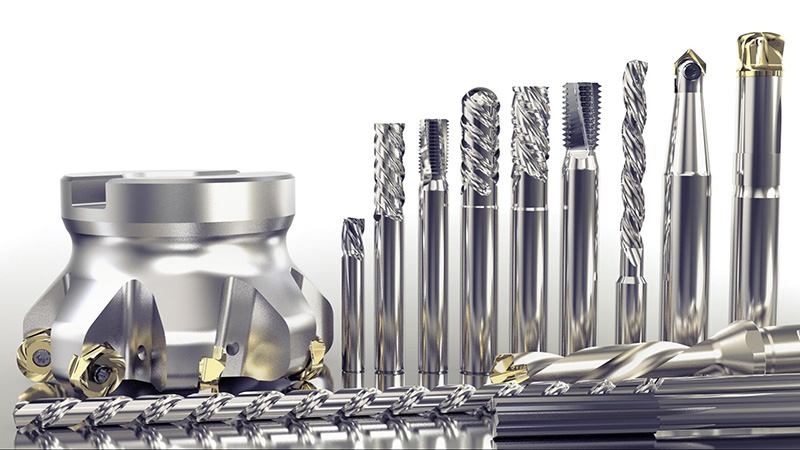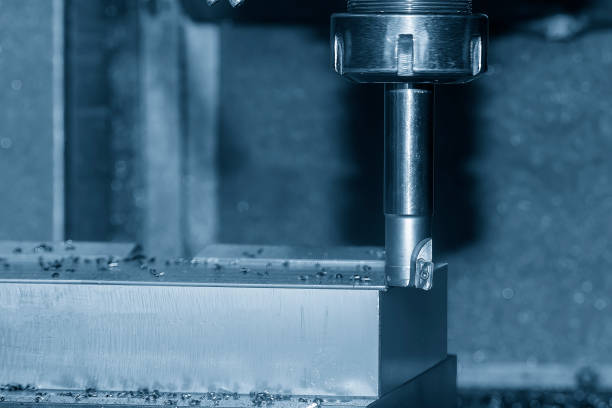ผ่านการเขียนโปรแกรมคอมพิวเตอร์ CNC (การควบคุมตัวเลขคอมพิวเตอร์) ควบคุมกระบวนการผลิตด้วยระบบอัตโนมัติที่แม่นยำ เครื่องจักรกำจัดการควบคุมด้วยตนเองโดยการส่งมอบผลลัพธ์ที่สม่ำเสมอตลอดการผลิต อุตสาหกรรมที่ใช้เทคโนโลยี CNC ใช้มันโดยเฉพาะสำหรับแอพพลิเคชั่นการบินและอวกาศการผลิตยานยนต์และงานโลหะเพื่อดำเนินการเช่นการตัดและการขุดเจาะและการหมุน
เครื่องมือเครื่องจักรกลซีเอ็นซีทำหน้าที่เป็นองค์ประกอบสำคัญที่ส่งผลกระทบต่อคุณภาพการผลิตและประสิทธิภาพการดำเนินงานในระหว่างกระบวนการ สิ่งเหล่านี้มีการใช้งานที่แตกต่างกันซึ่งรวมถึงการตัดวัสดุควบคู่ไปกับการสร้างวัสดุและกระบวนการตกแต่ง การเลือกเครื่องมือที่เหมาะสมช่วยให้เครื่องจักรการผลิตทำงานได้ดีที่สุดในขณะที่พวกเขาผลิตชิ้นส่วนตามข้อกำหนดที่แน่นอนและลดของเสียจากวัสดุ
แต่ละ เครื่องซีเอ็นซี ต้องใช้เครื่องมือเฉพาะสำหรับขั้นตอนการตัดเฉือนของแต่ละบุคคล เครื่องมือในการตัดเฉือนซีเอ็นซีประกอบด้วยการตัดอุปกรณ์เช่นการฝึกซ้อมและโรงงานปลายซึ่งจะลบเครื่องมือและเครื่องมือเปลี่ยนที่ดำเนินการกล่อม การเลือกเครื่องมือที่เหมาะสมยังคงเป็นสิ่งจำเป็นเพื่อให้ได้คุณภาพพื้นผิวที่มีความแม่นยำสูงและยอดเยี่ยมในระหว่างการเจาะการกดและการหมุน
ฟังก์ชั่น End Mills เป็นส่วนประกอบที่สำคัญของ CNC Milling เพราะพวกเขาอำนวยความสะดวกในการดำเนินการตัดหลายทิศทางซึ่งการฝึกซ้อมและเครื่องมืออื่น ๆ ไม่สามารถบรรลุได้ การเลือกโรงงานปลายทางโดยตรงเกี่ยวข้องกับลักษณะของวัสดุและพารามิเตอร์การดำเนินงานในขณะที่บัญชีสำหรับองค์ประกอบของความซับซ้อนของชิ้นส่วน
วัตถุประสงค์หลักของโรงงานระดับแบนนั้นเกี่ยวข้องกับการผลิตพื้นผิวเรียบเช่นเดียวกับการสร้างร่อง เครื่องมือวัดระหว่าง 1/16 " และเส้นผ่านศูนย์กลางหลายนิ้ว การสร้างคาร์ไบด์ของเครื่องมือตัดเหล่านี้ทำให้พวกเขาทำงานได้ในทั้งสองขั้นตอนการตัดเฉือน จุดสิ้นสุดของโรงสีตัดด้วยความเร็วระหว่าง 100 SFM และ 400 SFM ขึ้นอยู่กับประเภทของวัสดุและขนาดเครื่องมือและฟีดที่ระดับความลึกระหว่าง 0.002 "ถึง 0.020" ต่อฟัน
เครื่องมือที่มีรูปทรงโรงสีจมูกลูกเก่งในการผลิตรูปทรง 3 มิติที่ซับซ้อนและรูปร่างที่ซับซ้อน การออกแบบปลายโค้งมนของพวกเขาช่วยให้โรงงานปลายจมูกบอลสามารถส่งมอบผลลัพธ์การตกแต่งที่แม่นยำบนพื้นผิวทั้งตรงและโค้ง ช่วงเส้นผ่านศูนย์กลางสำหรับโรงสีจมูกบอลขยายจาก 1/32 " ขึ้นไป 2 ". เครื่องมือเหล่านี้ทำงานที่แถบความเร็วในการตัดทั่วไป 100 ถึง 300 SFM และต้องการอัตราการป้อนระหว่าง 0.001 "ถึง 0.015" ต่อฟันตามความแข็งของวัสดุ
กระบวนการตัดเฉือนของขอบ beveled ในส่วนต่าง ๆ ต้องใช้โรงงานปลายสุดเก๋ ช่วงมุมสำหรับโรงงานเปลี่ยนมุมขยายจาก 15 °ถึง 90 ° วัสดุคาร์ไบด์และ HSS สร้างโรงงานเหล่านี้ซึ่งให้บริการเป็นหลักสำหรับการดำเนินงานที่ทำลายขอบและงาน deburning เครื่องมือทำงานภายในช่วงความเร็วในการตัดระหว่าง 100 ถึง 300 SFM และจ้างอัตราฟีดจาก 0.002 "ถึง 0.012" ต่อฟัน
การตัดเฉือนรูกลมในวัสดุต่าง ๆ ต้องใช้เครื่องมือขุดเจาะเป็นส่วนประกอบที่จำเป็น การออกแบบการฝึกซ้อมนั้นแตกต่างกันไปตามการใช้งานที่ตั้งใจไว้ซึ่งกำหนดปัจจัยสำคัญของความแข็งแรงของวัสดุเชิงลึกและระดับความแม่นยำ
การฝึกฝนแบบบิดแสดงถึงประเภทการฝึกซ้อมหลักที่ใช้ในการเจาะรู มุมจุดของการฝึกฝนบิดมาถึง 118 องศา (135 องศาสำหรับวัสดุที่ยากขึ้น) และมีขนาดเส้นผ่าศูนย์กลางจาก 1/16 "ถึง 3" ความเร็วในการตัดสำหรับการฝึกซ้อมของคาร์ไบด์อยู่ระหว่าง 90 และ 300 SFM ในขณะที่เครื่องมือเหล่านี้ต้องการอัตราการป้อนระหว่าง 0.003 "ถึง 0.010" ต่อการปฏิวัติ ประเภทการเจาะนี้แสดงความยืดหยุ่นโดยการประมวลผลโลหะนอกเหนือจากพลาสติกและวัสดุคอมโพสิต
เครื่องกลึง CNC ที่ใช้เครื่องมือเปลี่ยนเครื่องมือสร้างชิ้นส่วนทรงกระบอกและเรขาคณิตทรงกลมจากวัตถุดิบ คุณภาพของพื้นผิวและความแม่นยำมิติถึงจุดสูงสุดผ่านการผสมผสานที่ลงตัวของมุมเครื่องมือและการออกแบบเม็ดมีดแบบตัด
กระบวนการเลี้ยวใช้เม็ดมีดแบบหมุนที่ทำหน้าที่เป็นส่วนประกอบปลายที่สามารถเปลี่ยนได้โดยใช้วัสดุไฮบริดคาร์ไบด์และวัสดุเซรามิกและ CBN คาร์ไบด์เครื่องมือเปลี่ยนเครื่องมือที่ใช้สำหรับการดำเนินงานมาตรฐานแสดงค่าความแข็งของ Vickers ตั้งแต่ 1500 ถึง 2000 HV เครื่องมือเซรามิกรักษาระดับความแข็งของ Vickers สูงได้รับการจัดอันดับระหว่าง 2000–2500 HV เพราะโครงสร้างที่เปราะบางของพวกเขาไม่ส่งผลกระทบต่อประสิทธิภาพความแข็งแรงโดยรวมในระหว่างการทำงานอย่างรวดเร็ว เม็ดมีด CBN บรรลุความต้านทานการสึกหรอที่ไม่ธรรมดาเนื่องจากคะแนนความแข็งของพวกเขาเกินกว่า 4000 HV คาร์ไบด์เม็ดมีดทำงานด้วยความเร็วตั้งแต่ 150 ถึง 400 SFM แต่เม็ดมีด CBN เข้าถึงความเร็วในการดำเนินงานจาก 250 ถึง 600 SFM สำหรับการประมวลผลวัสดุที่แข็งตัว
การเจาะปืนมีความเชี่ยวชาญสำหรับการขุดเจาะรูลึกซึ่งมักจะมีอัตราส่วนความยาวต่อเส้นผ่านศูนย์กลางสูงถึง 300: 1 เครื่องมือขุดเจาะใช้หลักการทางวิศวกรรมพิเศษเพื่อรวมช่องไอเสียที่ทำให้การกำจัดชิปเป็นปกติในระหว่างการทำงานของรูลึก การขุดเจาะต้องการการเปลี่ยนแปลงความเร็วระหว่าง 50 ถึง 200 SFM ที่มีลักษณะความลึกของรูและประเภทวัสดุโดยปกติกำหนดค่าความเร็วสุดท้าย กระบวนการขุดเจาะของเครื่องมือเหล่านี้ต้องใช้อัตราการป้อนระหว่าง 0.002 "และ 0.010" ต่อการปฏิวัติเพื่อให้ความแม่นยำในมิติพร้อมกับความแม่นยำทางเรขาคณิต
ฟังก์ชั่นของรีมเมอร์คือการทำรูเจาะเสร็จโดยการสร้างพื้นผิวที่แม่นยำหลังจากสร้างรูก่อนเริ่มต้น เครื่องมือในหมวดหมู่นี้ให้การออกแบบที่ปรับได้พร้อมกับการจัดอันดับความอดทนขั้นต่ำซึ่งขยายจาก ± 0.0001 "ถึง± 0.0005"- คาร์ไบด์และเหล็กกล้าความเร็วสูงสร้างฟังก์ชั่นรีมเมอร์จาก 50 SFM สูงถึง 150 SFM ขึ้นอยู่กับประเภทวัสดุ รีมเมอร์ต้องการอัตราการป้อนระหว่าง 0.001 "ถึง 0.005" ในระหว่างการหมุนแต่ละครั้ง
เป้าหมายหลักของเครื่องมือที่น่าเบื่อประกอบด้วยการเปลี่ยนแปลงมิติที่แม่นยำในคุณสมบัติของหลุมที่มีอยู่ก่อน Ensemble เครื่องมือที่รวบรวมได้ช่วยให้ผู้ใช้สามารถปรับเปลี่ยนหลุมได้ตามขนาดที่มีความเป็นไปได้สูงกว่าเครื่องมือเจาะมาตรฐาน เครื่องมือที่น่าเบื่อที่สร้างขึ้นจากวัสดุ BCN และคาร์ไบด์ทำงานด้วยความเร็วตั้งแต่ 50 ถึง 200 SFM ด้วยอัตราการป้อนวัสดุจาก 0.002 "ถึง 0.008" ต่อการปฏิวัติ

การออกแบบของเม็ดมีดขึ้นอยู่กับมุมของคราดซึ่งควบคุมประสิทธิภาพการตัด
● มุมคราดบวก: การตัดเฉือนวัสดุอ่อนผ่านมุมเรคบวกระหว่าง 10 °ถึง 25 °ช่วยให้แรงตัดลดลงด้วยประสิทธิภาพการทำงานที่ยอดเยี่ยม
● มุมคราดเชิงลบ: มุมเรคเชิงลบระหว่าง -5 °ถึง -15 °แสดงให้เห็นถึงความเสถียรของเครื่องมือที่ยอดเยี่ยมพร้อมกับความต้านทานการสึกหรอทำให้ดีที่สุดสำหรับการประมวลผลวัสดุเหล็กและไทเทเนียม
เครื่องมือในก๊อกและตายทำหน้าที่สร้างเธรดภายในในก๊อกข้างเธรดภายนอกในตาย เครื่องมือนำเสนอคุณสมบัติการใช้งานขั้นพื้นฐานในระหว่างการตัดเฉือน CNC ของงานเธรดโดยรองรับตัวเลือกการออกแบบต่าง ๆ ที่เหมาะสมสำหรับวัสดุและรูปแบบด้าย
เครื่องมือตัดที่เรียกว่าเครื่องมือการแตะมีอยู่ในสองรุ่นหลัก HSS และ Carbide ซึ่งตัดเธรดภายในโดยเฉพาะ แตะมือให้บริการการทำงานแบบเกลียวด้วยตนเอง แต่ระบบอัตโนมัติ CNC ต้องการก๊อกเครื่อง การควบคุมความแม่นยำของความคลาดเคลื่อนของเธรดจะทำงานภายใน± 0.0005 "สำหรับแอปพลิเคชันเกลียวที่มีความแม่นยำสูงช่วงความเร็วในการตัดสำหรับเครื่องมือการแตะขยายระหว่าง 30 ถึง 150 SFM ในขณะที่พิจารณาประเภทวัสดุและมิติเธรด
ฟังก์ชั่น Die Inserts เพื่อสร้างเธรดภายนอกบนวัสดุทรงกระบอก วัสดุ HSS หรือคาร์ไบด์เป็นพื้นฐานสำหรับเม็ดมีดตายที่เป็นไปตามมาตรฐานด้ายเช่น UN, Metric และ BSP ในระหว่างการทำเกลียวเครื่องจักรทำงานที่ความเร็วตั้งแต่ 50 ถึง 200 SFM เพื่อตอบสนองความต้องการที่มีความแม่นยำสูงในขณะที่รักษาความแม่นยำของเธรดภายใน± 0.002 "
สปินเดิลเครื่องซีเอ็นซีต้องการตัวยึด Collet เพื่อให้เครื่องมือตัดอยู่ในตำแหน่งที่แม่นยำ ผู้ถือเครื่องมือเปิดใช้งานการวางตำแหน่งศูนย์กลางที่แม่นยำและสร้างการสั่นสะเทือนของเครื่องมือน้อยที่สุดตลอดการใช้อุปกรณ์ การตัดรักษาตำแหน่งที่ปลอดภัยของพวกเขาผ่าน collets ที่ยืดและหดตัวเข้าด้วยกันเพื่อให้การทำซ้ำที่แม่นยำในการตัดเฉือน ผู้ถือ Collet มาตรฐานมีขนาดตั้งแต่ 1/16 "ถึง 1" ด้วยเหล็กและคาร์ไบด์ทำหน้าที่เป็นส่วนประกอบของอาคารพื้นฐาน ความเร็วในการทำงานของเครื่องมือเครื่องซีเอ็นซีถึงระหว่าง 500 ถึง 10,000 รอบต่อนาทีตามขนาดเครื่องมือและข้อมูลเฉพาะวัสดุที่ประมวลผล
ระบบหนีบที่เชื่อถือได้ของเครื่องซีเอ็นซีรวม Chucks สำหรับเครื่องมือและการเก็บรักษาชิ้นงาน การดำเนินการประมวลผลเครื่อง CNC ใช้ Chucks เป็นอุปกรณ์ยึดซึ่งใช้ชุดประกอบขากรรไกรกลไกเพื่อสร้างการเก็บรักษาเครื่องมือและชิ้นงานที่มีประสิทธิภาพ อุตสาหกรรมประดิษฐ์ Chucks โดยใช้เหล็กหรือเหล็กหล่อเพื่อยึดเครื่องมือตั้งแต่ 1 "ถึง 8" และเส้นผ่านศูนย์กลางใหญ่กว่า อุปกรณ์เหล่านี้ทำงานภายในระยะ 200 รอบต่อนาทีถึง 4,000 รอบต่อนาที แต่พวกเขายังคงมีแรงบิดที่แข็งแกร่งซึ่งช่วยให้เครื่องมือมีความเสถียรที่เชื่อถือได้
ตารางเครื่องใช้ Vices เป็นส่วนประกอบของฮาร์ดแวร์เพื่อให้ได้ตำแหน่งงานชิ้นงานที่เสถียร อุปกรณ์ให้การควบคุมการวางตำแหน่งงานที่แม่นยำซึ่งช่วยให้ผู้ประกอบการสามารถรักษาเสถียรภาพการปฏิบัติงานได้ แรงหนีบของ CNC Vice ขึ้นอยู่กับขนาดและการรวมกันของวัสดุตั้งแต่ 2,000 ถึง 10,000 N ตำแหน่งความชั่วร้ายเหล่านี้มีความแม่นยำถึง± 0.0005 "หรือความแม่นยำที่ดีกว่าและมีขนาดงานที่หลากหลาย
CNC เครื่องมือตัดโซลูชั่นการจัดเก็บข้อมูลผ่านกระเป๋าเครื่องมือที่จัดระเบียบเครื่องมือในการตั้งค่าเครื่องที่ใช้เครื่องมือเปลี่ยนเครื่องมืออัตโนมัติ (ATC) ความปลอดภัยของเครื่องมือผ่านการวางตำแหน่งที่เหมาะสมจะได้รับการบำรุงรักษาจากกระเป๋าเครื่องมือทำให้สามารถเข้าถึงเครื่องมือได้อย่างง่ายดายในขณะที่สวิตช์เครื่องมืออัตโนมัติทำงาน อลูมิเนียมและเหล็กที่มีความแข็งแรงสูงรวมกันเพื่อสร้างกระเป๋าเหล่านี้ซึ่งรองรับเครื่องมือตั้งแต่ 1/16 "ถึง 2" ในเส้นผ่านศูนย์กลาง กระเป๋าเครื่องมือช่วยให้การเปลี่ยนเครื่องมืออย่างรวดเร็วระหว่างขั้นตอนการผลิตที่นำไปสู่ช่วงเวลาหยุดอุปกรณ์ที่สั้นลง
ผลผลิตดีขึ้นสำหรับเครื่องซีเอ็นซีเนื่องจากการใช้ผู้ถือเครื่องมือเปลี่ยนอย่างรวดเร็วลดระยะเวลาการตั้งค่า การดำเนินการเปลี่ยนเครื่องมืออัตโนมัติถูกเปิดใช้งานโดยคุณสมบัติการมีส่วนร่วมของเครื่องมืออย่างรวดเร็วซึ่งให้ฟังก์ชั่นการปลดปล่อยอย่างราบรื่นซึ่งจะลบขั้นตอนการควบคุมที่ขึ้นกับผู้ประกอบการ การเปลี่ยนแปลงเครื่องมือด่วนเสร็จสมบูรณ์ใน 5-10 วินาทีผ่านการออกแบบระบบนี้ โลหะผสมเหล็กและอลูมิเนียมแข็งเป็นตัวยึดเครื่องมือเปลี่ยนเร็วซึ่งรักษาขนาดเครื่องมือต่าง ๆ ในขณะที่ทำงานด้วยความเร็วการตัดเฉือนความเร็วสูงอย่างปลอดภัย
กระบวนการต้องการโพรบสำหรับการวัดอย่างต่อเนื่องและการตรวจสอบส่วนประกอบ สัมผัสโพรบสัมผัสพื้นผิวชิ้นส่วนสำหรับการวัดขนาดผ่านการติดต่อที่แม่นยำ โพรบเหล่านี้ให้ความแม่นยำในการวัดตั้งแต่ 0.0001 "ถึง 0.001" ซึ่งเหมาะสมกับการตรวจสอบคุณสมบัติในระหว่างกระบวนการตัดเฉือน โพรบเลเซอร์สร้างโปรไฟล์ชิ้นส่วน 3 มิติโดยละเอียดโดยใช้เทคนิคการสแกนแบบไม่สัมผัสที่เข้าถึงความแม่นยำในการวัด 1 µm สำหรับการตรวจสอบเรขาคณิตที่ซับซ้อน
เครื่องมือวัดที่เรียกว่าไมโครมิเตอร์ให้ความแม่นยำเป็นพิเศษเมื่อวิเคราะห์ขนาดเล็กรวมถึงความหนาและเส้นผ่านศูนย์กลาง แอพพลิเคชั่นการวัดภาคสนามใช้อุปกรณ์เหล่านี้เพื่อตรวจจับขนาดด้วยอัตราความแม่นยำถึงช่วง 0.0001 "หรือ 0.001 มม. เมื่อนำไปใช้กับส่วนประกอบขนาดเล็กเช่นเพลาและไมโครมิเตอร์ตลับลูกปืนช่วยให้แน่ใจว่าชิ้นส่วนสอดคล้องกับข้อกำหนดการตัดเฉือน CNC ที่เข้มงวด
คาลิปเปอร์ให้บริการหลายฟังก์ชั่นเนื่องจากสามารถตรวจสอบขนาดภายในภายนอกและความลึกพร้อมกับขนาดของขั้นตอนซึ่งช่วยให้การตรวจสอบชิ้นส่วนที่ยืดหยุ่นในระหว่างกระบวนการตัดเฉือน คาลิปเปอร์ดิจิตอลสามารถวัดได้ด้วยความแม่นยำ 0.0005 "(0.01 มม.) ในระดับการวัด 0 ถึง 12" (0 ถึง 300 มม.) การออกแบบของพวกเขาให้การวัดที่รวดเร็วสำหรับชิ้นส่วนที่มีช่วงความอดทนปานกลาง
เทคโนโลยี CMM ขั้นสูงใช้กลไกความแม่นยำสูงในการตรวจจับขนาดของชิ้นส่วนในสถานที่เชิงพื้นที่ 3 มิติ Touch หรือ Laser Probes ช่วยให้การจับข้อมูลผ่าน CMM ซึ่งให้การวัดที่ดีกว่า 0.0001 "(0.0025 มม.) ความแม่นยำความสามารถในการวัดแบบเรียลไทม์

กระบวนการกำจัดวัสดุโดยการเสียดสีใช้ล้อบดในระหว่างขั้นตอนการบดพื้นผิวหรือทรงกระบอก เนื่องจากความต้องการพื้นผิวเสร็จสิ้นกำหนดการเลือกขนาดกรวดระหว่าง 24 และ 600 ล้อทำงานด้วยความเร็วระหว่าง 3,000 ถึง 6,000 รอบต่อนาที ล้อส่งทั้งพื้นผิวที่ละเอียดอ่อนพร้อมกับความสามารถในการกำจัดวัสดุที่มีประสิทธิภาพ
เสร็จสิ้นการขัดเงาของชิ้นงานเป็นผลมาจากการใช้แผ่นขัดรวมกับสารประกอบเป็นเครื่องมือที่เรียบและส่องแสง การดำเนินงานที่รอบตั้งแต่ 1,500 ถึง 5,000 รอบต่อนาทีเครื่องมือเหล่านี้กำจัดข้อบกพร่องของพื้นผิวเพื่อให้ได้เสร็จสิ้นการประณีต ขนาดกรวดที่แตกต่างกันที่มีอยู่ในสเปกตรัมจาก 50 เป็นหยาบถึง 2000 เป็นพิเศษเป็นพิเศษกำหนดระดับคุณภาพพื้นผิวของกระจกที่ต้องการ
เข็มขัดแซนเดอร์บรรลุเป้าหมายโดยใช้เข็มขัดขัดที่ไม่มีที่สิ้นสุดเพื่อให้ได้ความราบรื่นและกำจัดข้อบกพร่องของพื้นผิว ที่ 3,000 ถึง 6,000 ฟุตต่อนาที (fpm) เครื่องมือเหล่านี้ทำงานในขณะที่ใช้เข็มขัดที่วัดจาก 1 "ถึง 6" ชิ้นส่วนที่ต้องการการตกแต่งหรือการสร้างผลประโยชน์ที่ดีที่สุดจากปลายข้าวขนาดต่างกันระหว่าง 40 และ 400
หัวฉีดน้ำยาหล่อเย็นพร้อมกับระบบกระแสของเหลวโดยตรงเพื่อควบคุมอุณหภูมิและลดแรงลากในระหว่างขั้นตอนการตัดเฉือน CNC ระบบกำหนดเส้นทางสารหล่อเย็นไปยังทั้งพื้นที่การตัดและเครื่องมือในขณะเดียวกันก็ทำให้เครื่องมือและชิ้นงานเย็นลงพร้อมกันในขณะที่ถอดชิป ระบบหล่อเย็นส่งสารหล่อเย็นในช่วง 1-5 gpm พร้อมระดับความดันจาก 30 ถึง 1,000 psi เพื่อเพิ่มความทนทานของเครื่องมือและความเป็นเลิศส่วนหนึ่ง
ก่อนที่เครื่อง CNC จะได้รับเครื่องมือเครื่องมือล่วงหน้าดำเนินการประเมินทั้งมิติและขั้นตอนการแก้ไขมิติ เครื่องมือ presetters เปิดใช้งานการวัดขนาดเครื่องมือที่แม่นยำซึ่งสร้างความแม่นยำในมิติภายใน± 0.0001 "(0.0025 มม.) ประสิทธิภาพการตัดเฉือนดีขึ้นเนื่องจากระบบนี้ป้องกันการหยุดการเปลี่ยนแปลงระหว่างเครื่องมือและรักษาตำแหน่งเครื่องมือที่แม่นยำ
เครื่องมือกำจัดชิปที่มีประสิทธิภาพประกอบด้วยระบบสูญญากาศของสายพานลำเลียงและการระเบิดของอากาศที่ทำความสะอาดโซนตัด เครื่องมือรักษาสภาพแวดล้อมการปฏิบัติงานที่สะอาดโดยการกำจัดเศษซากอย่างต่อเนื่องซึ่งหลีกเลี่ยงการรบกวนในกระบวนการผลิต ระบบสูญญากาศให้กำลังดูดสูงถึง 1,500 CFM ซึ่งจัดการได้อย่างมีประสิทธิภาพในการโหลดชิป
ความอดทนสูงของเครื่องมือคาร์ไบด์ในการสึกหรอและวัสดุขัดทำให้เหมาะสำหรับรอบการผลิตอย่างรวดเร็วและวัสดุที่ขรุขระ เครื่องมือคาร์ไบด์ส่วนใหญ่ให้บริการวัตถุประสงค์ในกระบวนการตัดเฉือนที่สำคัญทั้งหมดของการเปลี่ยนการกัดและการขุดเจาะ คาร์ไบด์เครื่องมือยังคงมีประสิทธิภาพที่อุณหภูมิสูงซึ่งขยายขอบตัดของพวกเขาเพื่อให้พวกเขาสามารถจัดการกับวัสดุเช่นสแตนเลสและไทเทเนียมได้อย่างมีประสิทธิภาพ
ค่าทางเทคนิค: เนื่องจากความสามารถที่โดดเด่นของพวกเขาในการทนต่อความเร็วสูงของคาร์ไบด์เครื่องมือทำงานได้ดีที่สุดเมื่อใช้สำหรับการตัดที่ 300 ถึง 500 ฟุตต่อนาที (SFM)
วัสดุเครื่องมือเหล็กความเร็วสูง (HSS) แสดงให้เห็นถึงความเก่งกาจที่ยอดเยี่ยมเนื่องจากรักษาความแข็งในช่วงอุณหภูมิที่สูงขึ้น เครื่องมือนี้ใช้งานได้สำหรับข้อกำหนดการตัดเฉือนที่หลากหลายที่โดดเด่นที่สุดเมื่อทำการตัดอย่างแม่นยำในขณะที่แสดงให้เห็นถึงความทนทานต่อการสึกหรอที่ดี เครื่องมือ HSS แสดงให้เห็นถึงการรวมกันของความแข็งแรงและความทนทานต่อผลกระทบที่เหมาะสมสำหรับการดำเนินการที่ดำเนินการด้วยความเร็วที่ช้าลง
ค่าทางเทคนิค: ประโยชน์การตัดเฉือนทั่วไปจากเครื่องมือ HSS ซึ่งรักษาความเร็วระหว่าง 100 ถึง 300 SFM ด้วยการปรับเปลี่ยนแบบง่าย ๆ สำหรับค่าใช้จ่ายในการดำเนินงานที่ลดลง
เครื่องมือเซรามิกแสดงให้เห็นถึงความทนทานที่เหนือกว่าผ่านการต่อต้านการสึกหรอในขณะที่บรรลุความเร็วในการดำเนินงานเหนือสิ่งที่เป็นไปได้สำหรับเครื่องมือคาร์ไบด์และ HSS เครื่องมือเหล่านี้เก่งในการประมวลผลวัสดุที่ยากลำบากในขณะที่รักษาเสถียรภาพในระหว่างการปฏิบัติงานที่อุณหภูมิที่รุนแรง พื้นที่แอปพลิเคชันหลักสำหรับเครื่องมือเซรามิกเกี่ยวข้องกับการหมุนและขั้นตอนการตัดเฉือนความเร็วสูงเมื่อทำงานกับเหล็กหล่อเหล็กแข็งและโลหะผสมที่ใช้นิกเกิล
ค่าทางเทคนิค: เครื่องมือเซรามิกส่งมอบศักยภาพในการตัดความเร็วสูงเกิน 1,000 SFM จึงช่วยให้การดำเนินการเสร็จสิ้นความแม่นยำ
เนื่องจากเครื่องมือ Cubic Boron Nitride (CBN) ที่มีความแข็งสูงที่สุดอยู่ในระดับต่ำกว่าเพชรและยอดเยี่ยมโดยเฉพาะที่เหล็กกล้าแข็งตัวพร้อมกับวัสดุที่ยากต่อเครื่องจักร CBN ให้ความต้านทานที่เหนือกว่าการสึกหรอและความเสถียรทางความร้อนที่ยอดเยี่ยมซึ่งช่วยให้สามารถทำได้ดีในการท้าทายการใช้งานประสิทธิภาพสูงและความแม่นยำ
ค่าทางเทคนิค: เครื่องมือที่ทำจาก CBN เปิดใช้งานการใช้เครื่องตัดเฉือนเสร็จสิ้นด้วยความเร็วตั้งแต่ 400 ถึง 800 SFM และ Excel ในการประมวลผลเหล็กกล้าเครื่องมือชุบแข็งพร้อมกับเหล็กตายและวัสดุแบริ่ง
วัสดุเครื่องมือที่ทนทานที่สุดที่รู้จักกันในปัจจุบันคือ Polycrystalline Diamond (PCD) ซึ่งวิศวกรใช้สำหรับการตัดทั้งวัสดุที่ไม่ได้เป็นเหล็กและโครงสร้างคอมโพสิตและโลหะผสมอุณหภูมิสูง อายุการใช้งานที่ยาวนานของเครื่องมือ PCD ควบคู่ไปกับความต้านทานต่อการสวมใส่ทำให้การผลิตมีประสิทธิภาพสูงสำหรับการดำเนินงานการผลิตจำนวนมาก
ค่าทางเทคนิค: ความสามารถในการตัดความเร็วของเครื่องมือ PCD ถึง 1,500 ถึง 4,000 SFM และช่วยให้การประมวลผลวัสดุแข็งเช่นอลูมิเนียมพร้อมกับทองเหลืองและกราไฟท์
กระบวนการผลิตเครื่องจักรกลซีเอ็นซีขึ้นอยู่กับเครื่องมือตัดควบคู่ไปกับผู้ถือเครื่องมือและเครื่องมือวัดรวมถึงเครื่องมือเสริมเพื่อให้ได้ความแม่นยำและประสิทธิภาพ กระบวนการตัดเฉือนที่เหมาะสมกับวัสดุและแอพพลิเคชั่นที่หลากหลายใช้วัสดุเครื่องมือตั้งแต่คาร์ไบด์ไปจนถึง CBN และ PCD HSS และเซรามิกเพื่อเพิ่มประสิทธิภาพประสิทธิภาพพิเศษ
การใช้เครื่องมือที่เหมาะสมส่งผลให้ประสิทธิภาพสูงสุดพร้อมกับผลลัพธ์ที่แม่นยำและความทนทานของเครื่องมือที่เพิ่มขึ้น ทางเลือกของเครื่องมือที่เหมาะสมช่วยเพิ่มประสิทธิภาพการตัดเฉือนในขณะที่ลดของเสียและช่วยให้ความคลาดเคลื่อนที่แม่นยำซึ่งผลิตผลิตภัณฑ์คุณภาพสูงและเพิ่มประสิทธิภาพการผลิต